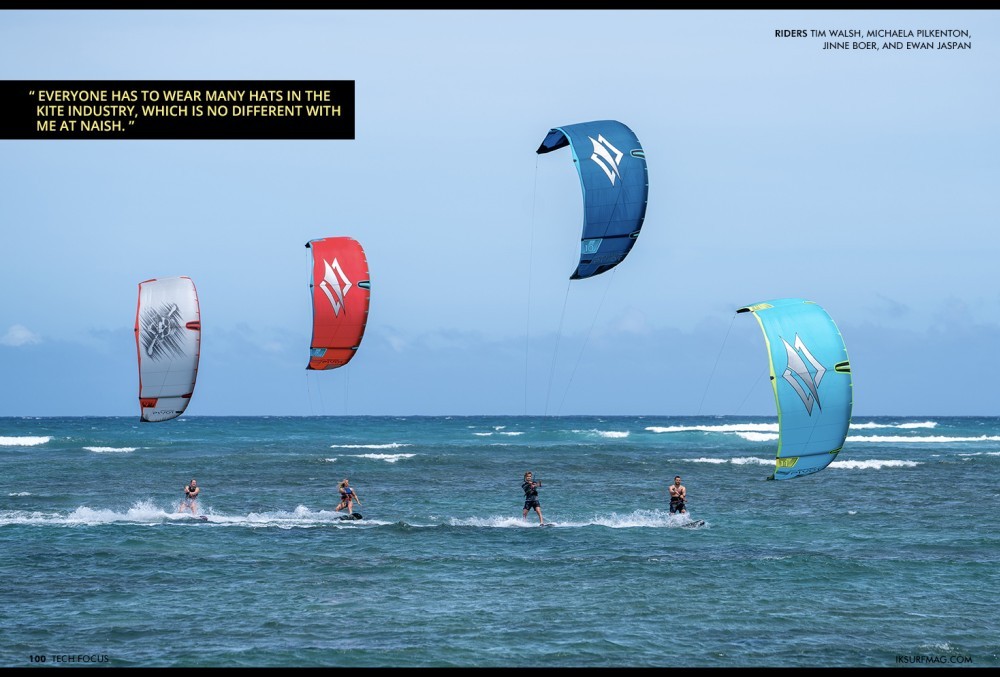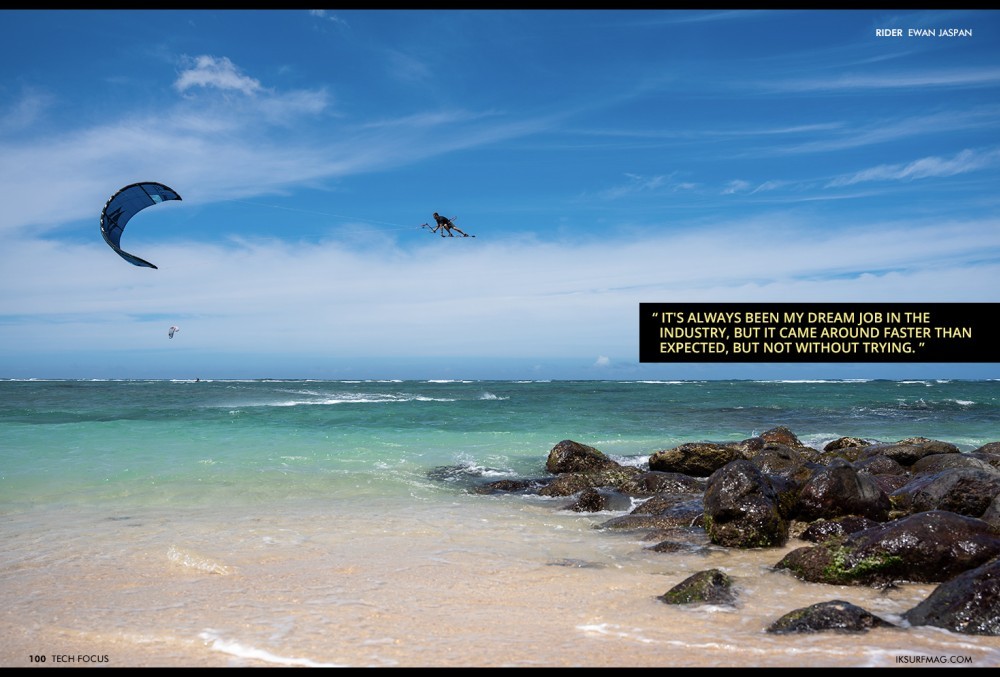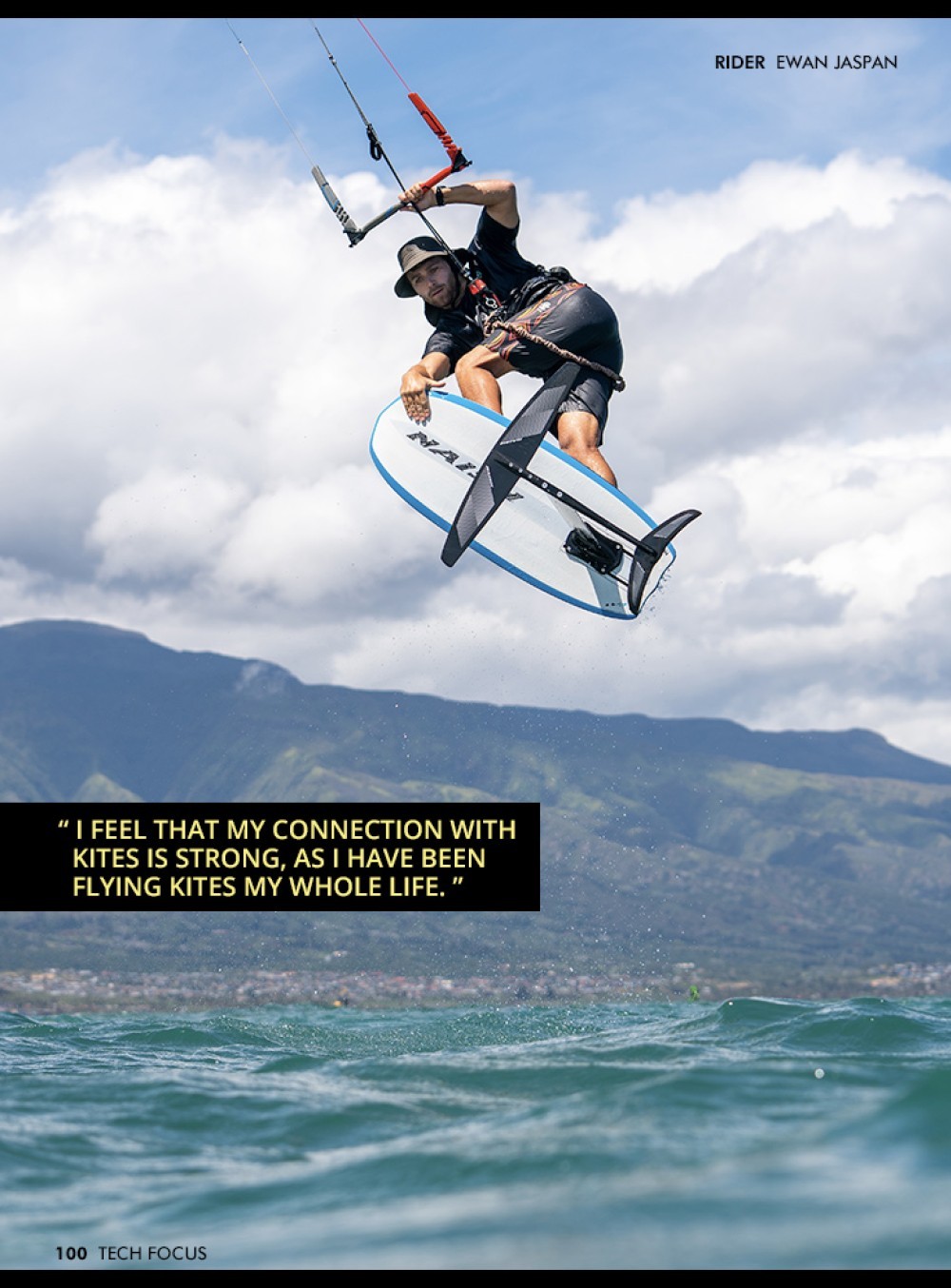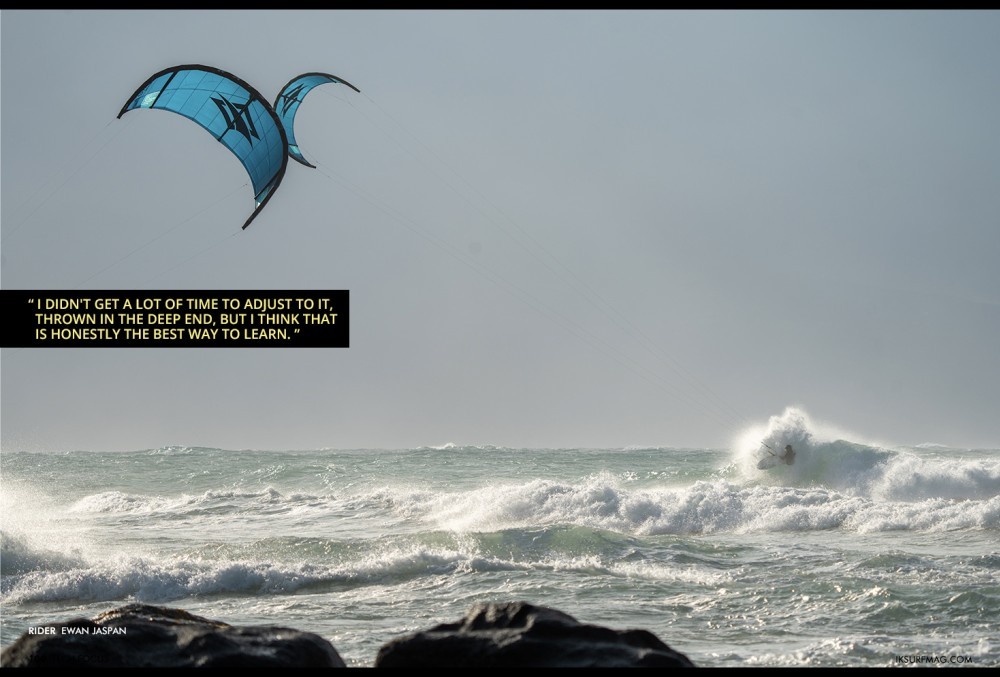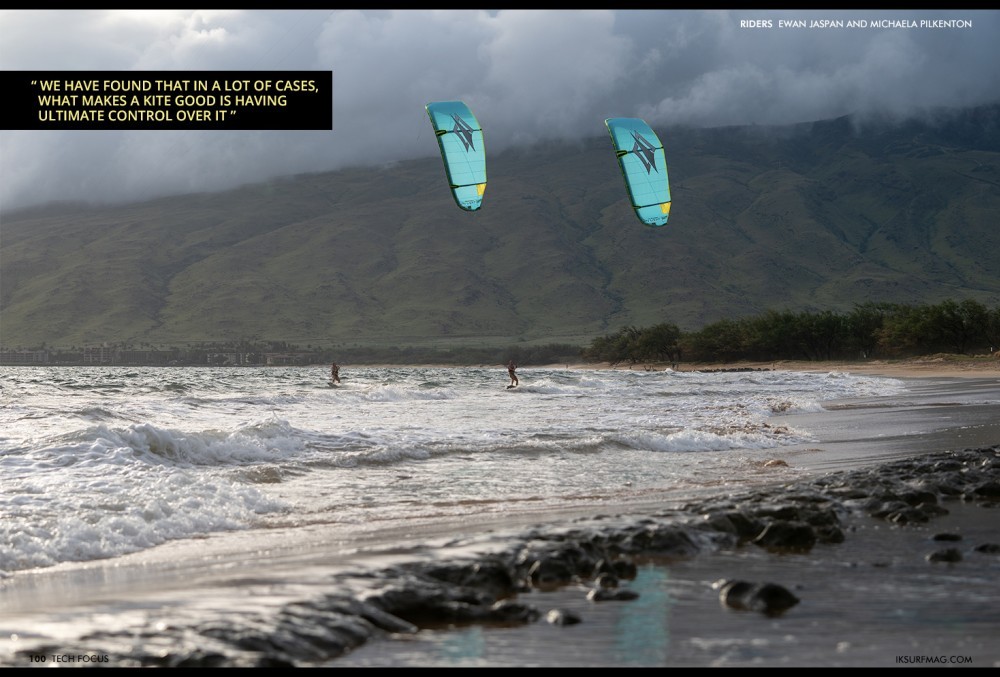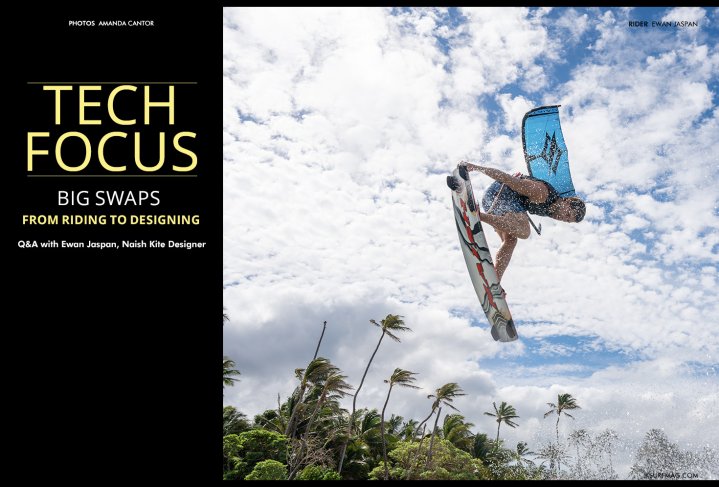
Tech Focus: Big Swaps - From Riding to Designing
Issue 100 / Wed 9th Aug, 2023
There's big news over at Naish Kiteboarding, with a newly updated product range hitting the market this month, and some big changes to the development team, with Pro Rider Ewan Jaspan stepping into the role of Kite Designer. We caught up with Ewan in this Q&A to discover what's new at Naish!
Ewan, congrats on the new role! We wondered why your social media has been quiet lately, but you've clearly been very busy with your new job! Tell us what the role of kite designer entails for you. What does a day in the life of Ewan Jaspan, Kite Designer, look like?
Ha! Yeah, I have been quiet on the socials. My job now is definitely focused on being a kite designer and not a social media rider. I still do many things as a team rider, but I have taken a bit of a break from social media, as I have been active there for so many years out of necessity and have never been a big fan.
As a kite designer now, my role entails designing the kites on the computer, managing the production with the factory, identifying new development paths, a lot of bridle work on the beach, talking to importers and dealers, and so on. Everyone has to wear many hats in the kite industry, which is no different with me at Naish.
As a highly accomplished athlete featured on the cover of this magazine twice, have there been any challenges in transitioning from pro rider to kite designer? Can you share some details of your journey with us and what inspired you to make this transition?
There have for sure been quite a few adjustments to be made. I no longer get to think about my next 3-month long trip and what tricks I will learn, and try to prove myself in the realm of pro riding. But that is ok with me. I did it for ten years and want to progress my career further while still riding nearly every day.
Over the years, I have always thought, and been told plenty of times, to have a backup plan from my professional athletic career. Injuries can hit quickly, as can age, and before you know it, you can be washed up, asking a brand for a job with no experience or skills beyond riding. I was conscious of this, but university was just never for me. I did a diploma in Marketing while I was injured and younger, but I couldn't stand taking the tram into the city every day and sitting in a classroom.
I have always been interested in tuning kites and making them fly better while keeping up with all the latest industry tech and developments, which led to me constantly bugging the design team in Maui. After a while, I stayed longer around photoshoot trips and took a much deeper interest in bridle work and design. It's always been my dream job in the industry, but it came around faster than expected, but not without trying.
As a long-time team rider for Naish, what unique perspectives and experiences do you bring to the table as a kite designer?
As a pro rider, you are pretty in tune with the gear you are riding and others' gear around you. Some take more of an interest than others, but in general, most pros have a great understanding of how gear works. Additionally, we spend years travelling the globe, running demo days, talking to shops and customers, and having a great overview of the entire industry from the inside out. This has really helped me shape a great view of where all the strengths and weaknesses lie in product lines and help craft designs at Naish, which leave no weak spots and excel exactly where they should.
Kite design is a complex process involving various tools and experience. What specific aspects of kite design come most naturally to you? Has there been a big learning curve?
Knowing what I want to achieve in a kite and analysing the focus points on a kite come naturally to me. I feel that my connection with kites is strong, as I have been flying kites my whole life. Testing was always a strong point of mine, and then moving into bridle work, learning from the best (Des Walsh) was a great start and a really organic way into it. The big learning curve has been the more 'classic work' side of the job—the computer time and meetings, which I need to plan my days around.
As a pro rider, our schedules are loose, and most of our efforts involve thinking of new tricks, cool video ideas, or time spent travelling or recovering. It has been quite rewarding to have more of a schedule and make real progress in a new aspect of life, but a challenge too. Learning to communicate with factories and work on much more strict time schedules than before has been necessary, and I didn't get a lot of time to adjust to it, thrown in the deep end, but I think that is honestly the best way to learn.
Could you provide some insights into the research and development process at Naish? How do you collaborate with other designers and team members to create innovative kites that meet the ever-evolving demands of the kiting community?
Our design team is evolving at the moment, and we are very excited about this. As most people know, Naish is now a truly global company, with employees across the new office in Nijkerk in Holland, Hood River and, of course, Maui. This means that along with our existing team, we now compile feedback and inspiration from many different communities and viewpoints. I think this will create a more well-rounded and concise line over the coming years and draw expertise from more high-end, talented people. We communicate online a lot, make a lot of phone calls, but most importantly, we catch up face-to-face and test and develop together as much as we can. I spend a lot of time on Maui, and currently, Tim, one of our main test riders, is located in Hood River, with me, for the summer and working on the new products. We also often talk to our dealers and importers to analyse market trends and keep at the forefront of development.
How do you balance the needs of different riders from different disciplines or from beginners to advanced athletes? What factors do you consider when creating kites that cater to a wide range of skill levels?
We have a very well-thought-out and balanced kite lineup at Naish. We are sure to do what the market wants, but not forget our roots, and always produce gear for all aspects of the sport. We are now producing gear that can take you to the top of any podium in the world, with the Pivot for big air (new big air products are coming soon), the Torch for anything and everything unhooked, the Triad for waves, and the Boxer to do the most high end foiling and pushing the limits of light wind. To go with this, the Pivot is also a true all-rounder, a kite that can suit anyone to do almost anything. The Triad has been refined into a super consistent and easy-to-predict kite, which is great for not only wave riding but beginner/intermediate twin-tip riders.
We have found that in a lot of cases, what makes a kite good is having ultimate control over it, which is something we aspire to achieve across the board. Control is something that helps riders of all levels progress, from beginner to pro level, as you feel comfortable with your equipment and focused on the task at hand.
Naish has a reputation for producing high-quality kites. What innovations can we expect to see in the next generation of Naish kites, and what challenges did you face in implementing these changes?
We have some exciting new products coming up soon, and on my end, kites. We have been working with some exotic materials, which have enabled us to majorly alter existing designs and create completely new designs to match the current era of the sport. Working with and figuring out how these new materials behave, perform, and must be constructed has been the biggest challenge so far. Putting new material in the kite is almost like creating a new kite from scratch. Another great project I have been involved with is creating a new wave style kite, which is convertible between wave and easy/beginner free ride with bridle changes. But on most of the information, you will just have to wait until January….
With the surge in talent and progression within areas like big air kiteboarding, there are claims that kite gear is lagging behind and needs to catch up. What are your thoughts on this? How much more evolution do you see in kite design, specifically for big air? Furthermore, do you believe that companies will start producing competition-grade kites that are not readily available for mass production?
I think this is something we need to be very careful of in big air kiteboarding. Specialised freestyle kites got quite one-dimensional and hard for the average person to use, and this is one of the reasons freestyle kiteboarding is having a bit of a flat period. This is without the introduction of expensive high-end materials, so you can imagine how pigeonholed a one-discipline kite made out of expensive materials may get. This is something we want to avoid, and we make sure our kites are always great for all kiters and not just marketed towards the next 17-year-old kid busting double loops. There always has to be a balance, and making gear that performs highly is, of course, a massive goal of ours, but it has to be sustainable. Right now, there is definitely some huge development going on, and kites are jumping and looping higher than ever before, with access to these heights also being easier than ever before, so that is exciting to be a part of.
Where do you see the direction of the sport going in the coming years? How do you envision your role as a designer influencing and shaping the future of kiting?
I see kiting going into a period of free riding and riding whatever the conditions offer. I don't see one specific discipline dominating the sport again for a while, as I think people will realise the best thing about kiting is that you can do almost anything, whether it be riding a wave, foiling, hitting a rail, finding natural features, exploring new places, boosting to the moon, or learning a new technical freestyle trick; it all has its place, and it is all kiteboarding. This is what I love to do, and I think with the gear becoming so accessible, more people will find themselves riding new disciplines that are suited to the conditions. I want to make gear that is just fun to ride and makes you want to get out there and be on the water as much as possible; that is what makes me happy.
In light of recent controversial news, it has been reported that you have been spending a significant amount of time on the water practising disciplines other than kitesurfing. Can you shed some light on this and explain how these alternative water sports have influenced your approach to kite design at Naish?
Again, alluding to my last response, I try to always do what the conditions are best for. I don't find myself to be a snob of a certain discipline, and I know this may cause some tension in the Bant Camp, but I will wing when the wind is strong and the swell is firing! Haha. Honestly, these different sports and disciplines help keep my motivation to kite high, and seeing the development processes from other sports (such as surfing, biking, wake, wing, foil etc.) is great to apply to my kite design thoughts.
Do you still plan to compete in kiteboarding events despite your transition from being a Naish Team Rider to a Naish Kite Designer? If so, how do you balance your competitive aspirations with your responsibilities as a designer?
I do still plan to compete in some events. I am about to compete in the BAKL in Hood River and the KPL too. It is no longer something I am chasing, but definitely not something I am giving up on. I still love it, and I plan to push my level in the sport just as hard as before, but now more as my hobby than my job, which is nice as there is no pressure to do well, except for my own competitive nature. I think the balance is just like any other job/hobby combination. Plenty of people out there manage to excel in a sport while holding down a job; it actually makes it easier to do so with my hobby and job being in the same industry. I have to be on the water to test gear, and then in my free time, I get to take out a Torch and hit the park! Perks of living in such a great windy spot!
By IKSURFMAG




